
In this Super Strat guitars article, I’ll tell you how you can modify your guitar, so it plays better and sounds more aggressive. If you enjoy playing difficult tunes with fast tempos and complicated lead lines, here are some things that will turn your “mild-mannered” guitar into a shred machine on steroids!
If you are in a hurry, click here to go directly to the modifications you can make to your Strat-type guitar; otherwise, keep on reading.
You can use the table of contents below to take you to the area that interests you. Click on the little box to open it, and then click on the section of the article you want to read, or you can read from start to finish if you want the full Super Strat experience!
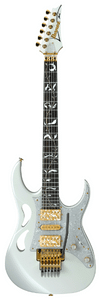
What Is A Super Strat?
A “Super Strat” is a guitar with a Strat-like body shape that has been enhanced to look, sound, and play better. It’s like sending your guitar to Gold’s Gym to get pumped. They first began appearing in the 80s with the advent of big hair metal, Marshall JCM-800 stacks, the Floyd Rose double-locking tremolo, and replacement pickups.
Companies like Kramer and Charvel came out with some of the first “ready to shred” axes. It wasn’t long before players began modifying their Strats to get the job done.
See Kramer Baretta Review – Great Playability And Awesome Sound! for more info.
What Is The Difference Between A Strat And A Super Strat?
The main differences between these two guitars are functionality, playability, and sound. They can look very similar to a standard Strat or remarkably different. For example, a standard Strat modded with hot-rodded single-coil pickups could be considered a Super Strat.
A Super Strat can change your approach to playing music. The pickups really push the front-end of an amp to bring out the guitar’s harmonics and make notes squeal while the whammy bar “divebombs’ magnificently without putting the guitar out of tune.
In its most glorious manifestation, a Super Strat is fully equipped with all the high-performance parts that make it a total shredding monster, like the Steve Vai PIA guitar pictured above.
Some Super Strats look like an evil experiment that came to life, like Eddie Van Halen’s “FrankenStrat!” Eddie made this guitar from spare parts by ripping apart a Kramer Strat copy.
He took out the tone knob and pickup selector switch and wired a wax-potted Seymour Duncan SH-11 Custom bridge position humbucker to a CTS 500K audio taper volume control with an MXR knob. Eddie made the Frankenstrat guitar come to life with an Original Floyd Rose bridge, and an R2 locking nut … Evil Stitched To Evil! ?
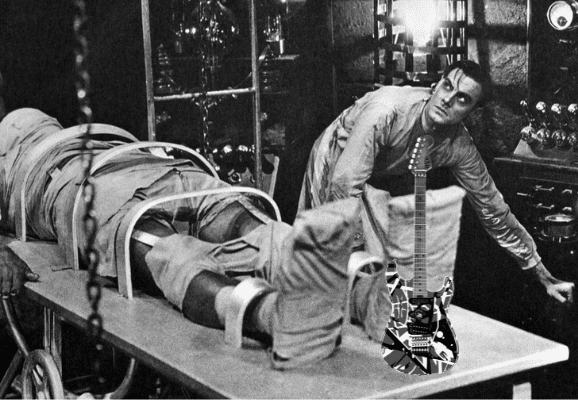
What Is Shredding? (in case you don’t already know)
Super Strats are typically used for “shredding,” but they can be used to play any music. Shredding refers to playing high-speed lines using scales and arpeggios. Long, flowing (legato) passages and two-handed tapping are very commonly used. If you are not familiar with the concept, have a listen to the song “Eruption” by Van Halen.
If you listen to players like Steve Vai and Joe Satriani, you already know some of the best shredders that planet earth has to offer!
Not all shredders play Rock and Metal. Check out Al Di Meola, who plays Latin-based tunes and world music, and Allan Holdsworth, who played fusion.

Characteristics Of A Super Strat
Here are the things that are commonly seen on Super Strat guitars.
They make the guitar sound better, easier to play, and can add a bit of a cool visual factor.
Neck, Fingerboard, And Frets
- Slim profile neck
- Flat or compound radius fingerboard
- Jumbo frets
Body
- Deep Cutaways
- Contoured Heel
- Neck Through the Body Design
Hardware
- Locking tuners
- Locking or Self-Lubricating Nut
- Locking Bridge
- Strap Locks
- High-Performance Strings
Electronics
- High-Performance Pickups
- Low-Friction Volume and Tone Controls
- Pickup Selector “Super Switch”
- Low-Noise Electromagnetic Shielding
Keep On Reading To Learn More About Each Topic
Neck, Fingerboard, And Fret Modifications
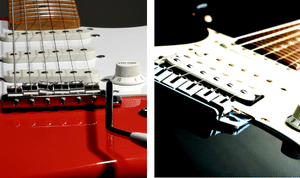
(9.5″ – Right Photo) Fingerboards
Your guitar neck can make a huge difference in playability. If you do a lot of finger vibrato, string bending, or tapping, a flatter fingerboard with larger frets is ideal.
If your guitar has a bolt-on neck, it’s pretty easy to swap it out for one that’s flatter with jumbo frets, assuming it has the same scale length. Fender Strats commonly have a 25.5-inch scale length.
These days, most “Metal” guitars have a 12-15 inch fingerboard radius.
Guitars with “compound radius” necks are more curved near the nut and get progressively flatter as you move up the neck. This gives you a good compromise between banging chords and shredding leads.
Strats with “vintage necks” have a 7.5-inch (curved) fretboard radius and low-profile frets, which is probably the most challenging neck to shred on.
Related Article ➡ How Long Do Guitar Frets Last? – Your Essential Guide!
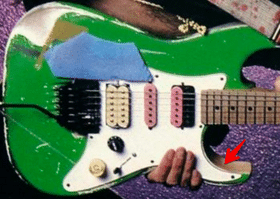
Guitar Body Considerations
I’ve seen players swap out a poor upper-note-access guitar body but use the shredding-friendly neck; however, that’s pretty unusual!
Typically, if a guitar’s body is not the best for shredding, it’s probably time to sell the instrument or use it for something else.
Lower Horn Narrowing
Steve Vai had his Charvel “Green Meanie guitar body sanded down on the inner aspect of the lower horn for better upper register access.
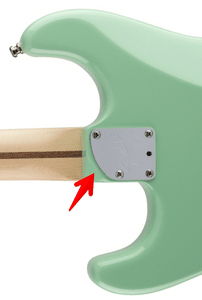
If you’re good with sanding equipment, you could make this modification or take it to someone that works on or builds guitars to have it done.
Contoured Body Heel
The other modification that can be made is to contour the neck heel. The heel is essentially sanded at an angle, which brings the palm of the hand closer to the neck.
If you contour the neck heel, you’ll have to buy a contoured neck plate or modify the one you already have.
Additionally, you’ll have to fill in the empty hole (near the red arrow) and drill a new one to attach that side of the neck plate to the guitar body and neck.
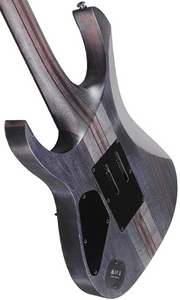
Neck-Through-Body Design
Some guitar bodies come with a “neck-through-body” design, which eliminates the neck heel since the neck is not joined to the body.
This design improves the guitar’s sustain and gives you maximal ease of access to the highest notes on the neck.
There is no way to sand enough wood away to create a neck joint with this shape on a guitar with a bolt-on or glued-in neck.
If you want a neck-through-body design, you’re looking at buying a new instrument.
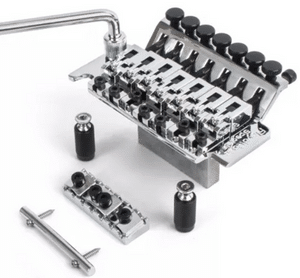
Hardware Updates
The right hardware can significantly improve the mechanical function of your guitar in any number of ways.
Double-Locking Tremolo System
If you use a whammy bar consistently in your playing, one of the best modifications you can make is to install a double-locking tremolo system, especially if you are a “divebomb addict.”
It will keep your guitar in tune by Iocking the strings at the nut and the bridge and can give you a more accurate pitch control when using the bar.
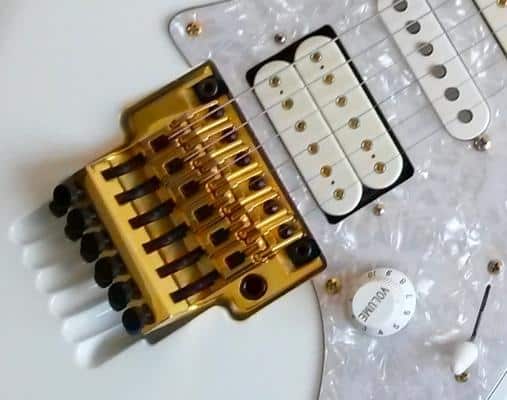
The Floyd Rose Double Locking System is by far the most popular Strat-type tremolo. Installation of the posts and locking nut will require modification to your guitar.
You may have to route the guitar body if you want it to be “floating” (set up to raise and lower the pitch), depending on the previous bridge setup and the amount you want to raise the pitch of the strings.
If you’re not familiar with using a router and making routing templates, it’s not something you should fool with.
The Ibanez JEM 777 guitar is routed to give the Floyd Rose Tremolo System maximal versatility.

D-Tuna
If you play a lot of songs in Drop D tuning, consider adding a “D-Tuna” device to your tremolo.
The EVH D-Tuna System was designed by Eddie Van Halen to quickly change his guitar back and forth from standard to Drop D tuning without having to change guitars during a performance.
The D-Tuna was made to retrofit most Floyd-Rose-style tremolo systems.
Locking Tuners With A Roller Nut

The next best thing to a double-locking tremolo system is to install a set of locking tuning machines and a roller nut. This setup will give you quite a bit of tuning stability.
The Fender LSR roller nut is an excellent choice for a Strat-type neck. It installs in place of a standard nut but will require some modification to the nut slot of the neck.
It’s essential to get the scale length (the distance between the nut and the 12th fret times two) correct, or the guitar’s intonation will be off.

The other way to go is to use locking tuners and a self-lubricating nut. See TUSQ XL Nut Review – Make Your Guitar Sing Like A Canary! for more info.
Strap Locks

Strap locks can make your guitar safer by preventing the strap from coming off while doing your flashy guitar tricks, like spinning the guitar around your back in the middle of a solo.
They are pretty easy to install. See Best Guitar Strap Lock System Review – The Top 10 Winners! for more info.
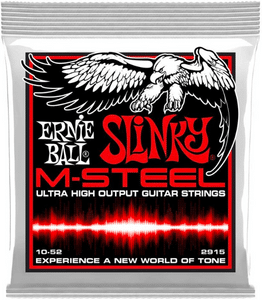
High-Performance Strings
A high-performance guitar needs high-performance strings! Even with the best pickups, the volume and tone of your sound are highly dependent on the metallic composition of the string materials and string gauge.
Higher gauge (thicker) strings will increase the strength of the output signal.
For example, Ernie Ball M-Steel strings use a super cobalt alloy wrapped around a managing steel hex core wire to improve frequency-response-dynamics and output.
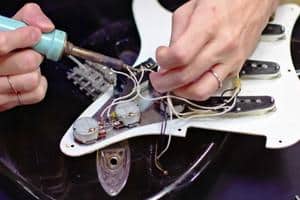
Electronic Tweaks
Your electronics can make or break the sound of your guitar, especially the pickups!
High-performance Pickups
“High-performance” pickups in a Super Strat usually mean higher output with a more aggressive tone profile. They can be arranged in a variety of pickup combinations.
Pickup Combinations
The most common pickup combinations for a Super Strat are:
- Humbucker in the neck and bridge position (H-H)
- Single-coil in the neck and middle position with a humbucker in the bridge position (S-S-H)
- Single-coil in the neck, middle, and bridge position (S-S-S)
- Humbucker in the neck and bridge position with a single-coil in the middle position (H-S-H)
Pickups can be replaced singly, or you can get them prewired on a pickguard, complete with the volume and tone controls and switches. Prewired pickup sets come ready to solder to the guitar’s output jack.

Prewired Pickguard
Passive Pickups
Passive pickups are most commonly found in Super Strats and other guitars. They are a single-coil or humbucking pickup wired to the other electronics (volume, tone, and selector switch) of the guitar.
My favorite single-coil high-performance passive pickups are Fender Custom Shop pickups. If you’re interested in learning more, see Fender Custom Shop Stratocaster Pickups – Which Set Is Best? for more info.
I also use Seymour Duncan “Hot Rails,” which are my favorite Strat humbuckers that fit in a single-coil pickup cavity for playing Rock and Metal.
Pickup installation is usually straightforward, especially if the pickup cavity is already in the proper shape and size, unless you want to replace a single-coil pickup with a standard-size humbucker, which will require the pickup cavity to be routed larger.
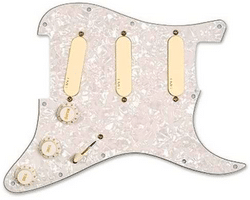
Check Price On Amazon
Active Pickups
Active pickups are attached to circuitry inside the guitar that allows you to shape the tone and adjust the gain of the pickups.
They usually run on a 9-Volt battery but can also be rechargeable (e.g., Fishman pickups).
One of my favorite active pickup sets is the EMG David Gilmour Artist Pro Series. It comes prewired on a pickguard and runs on a 9-volt battery. They are also available separately as EMG DG-20 active pickups.
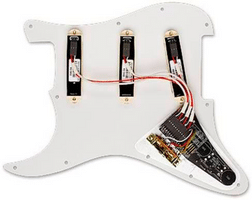
Rear View
The active circuitry gives you an “expander” and “presence” control, which allows you to have independent control over the treble and bass frequencies!
The pickups are noiseless and have very little magnetic string pull, which improves sustain and makes the strings easier to bend!
If you’re interested in grabbing one for yourself, click the yellow button to check availability, user reviews, and current pricing.
I installed the EMG DG-20 prewired pickup set in a guitar I built and routed the tremolo cavity to hold the battery like the Eric Clapton Strat does. I also reshaped the pickguard to make it look more original and show more of the wood of the guitar body.
It’s exactly the same pickup set that David Gilmour had installed in his “Red Strat.” The guitar sounds fabulous and plays great.
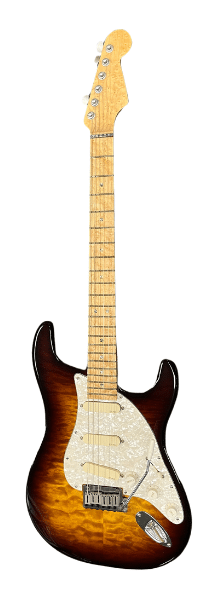
Here are the guitar’s specs:
- Compound radius neck – Bird’s eye maple fingerboard
- Fender Schaller Locking Tuners with LSR roller nut
- Walnut chambered body with quilted maple top
- Fender American 2-Point Synchronized Tremolo with 6 Stainless Steel Saddles
- EMG-DG20 David Gilmour active electronics with custom routed battery compartment in tremolo cavity
You can place the 9-volt battery under the pickguard in the guitar’s control cavity, but you have to remove the strings when the battery dies, which is a real hassle!
If the control cavity is in the back of your guitar, you can probably fit the battery there.
Low Friction Volume And Tone Controls
Low-friction audio-taper volume and tone controls are a great and cost-effective way to beef up your guitar’s performance!
Eddie Van Halen put a low friction audio-taper volume control (potentiometer or “pot”) in his Frankenstrat guitar, which allowed him to quickly and accurately perform volume swells without clicks or pops.

You can buy EVH pots, rated 250K for single-coil and 500K for humbucker pickups.
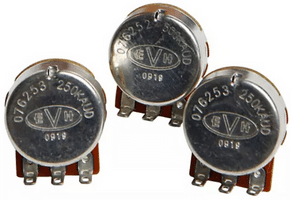
For Single-Coils
They were previously only available (in the EVH brand) preinstalled in the Wolfgang USA guitar, but now they are available to buy separately!
The are other electronic companies that make low-friction pickups, as well.
Pickup Selector “Super Switch”
Super switches are an excellent way to increase the versatility of guitars that have more than one pickup!

Super Switch
You can use them to wire pickups in parallel, series, or series-parallel combinations and split humbucking coils without installing additional switches to work with the main pickup selector.
They are commonly used on guitars with humbuckers in the neck and bridge positions and a single-coil in the middle (H-S-H).
Free-Way makes a 5-way 10-position super switch. It looks like a 5-way blade switch, but the blade moves from side to side to give you an additional set of 5 pickup combinations.
Super switches may require you to modify your pickguard or control cavity, depending on your setup.
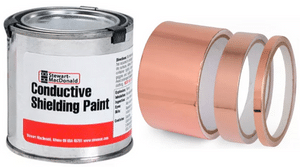
Low-Noise Electromagnetic Shielding
Guitars with single-coil pickups can be problematic unless they are noiseless!
To help tame noisy pickups, it’s good to add some electromagnetic shielding to your guitar’s control cavity, especially if you use overdrive, distortion, fuzz, or a high-gain amp.
You can either use shielding tape, shielding paint, or both. I routinely shield all the guitars I build so that any type of pickup can be installed and switched to another model in the future.
Stewart-MacDonald makes outstanding shielding paint and tape in various widths. I only use StewMac products to shield my guitars!

Advantages Of Super Strats
Generally speaking, Super Strats have the following advantages over regular Strat-type guitars.
- Ideal for shredding Rock and Metal
- Easier for bending strings, doing finger vibrato, and sounding harmonics
- Stay in tune better
- More versatile
- Look better on-stage

Disadvantages Of Modifying Strat-Type Guitars
- May be difficult to do it yourself & too costly to have done
- Mistakes can cause permanent damage to the guitar
- Replacement parts can be difficult to find
- Guitar may not sound or play better after modifcations
- Modifications can lower the guitar’s resale value
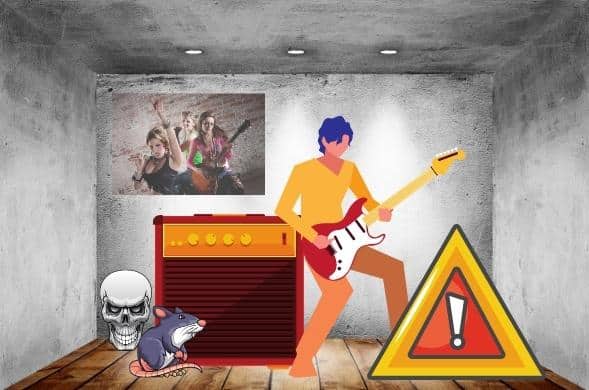
Not All Guitars Should Be Modified!
Before modifying your Strat or other guitars, there are some things to consider. If you paid a lot for your guitar or it is a vintage guitar, modifying it can significantly lower its resale value!
Lower-end guitars, such as Strats in the Fender Squire Bullet and Affinity line, are good to experiment with, especially if you do the modifications yourself. Squire guitars also play well enough to be used by some pros so that you won’t be upgrading a guitar with little to no value.
If you modify a guitar, always keep the original parts, in case you want to restore it to its original condition or sell the instrument.
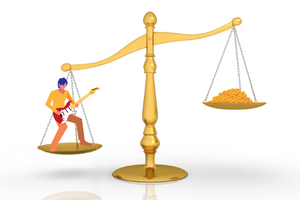
Is Building Super Strats Legit?
Eventually, many guitar players get to a point where they want to try to improve the sound of their trusty Strat. They change one thing here and one thing there.
Perhaps you love the feel of that worn-in neck, or there are too many great memories in the guitar to trade it in for something that sounds better.
You add some locking tuners, a graphite nut, and change that single-coil bridge pickup to a hot humbucker, and before you know it, you’ve got yourself a Super Strat!
Players have been modding their guitars even before Les Paul put the talk-piece from an old telephone under the strings of an acoustic guitar! Hot-rodding Strats to take your playing to the next level is super-legit.
What is the best Super Strat? It really comes down to personal preference, so If the mod makes sense and is cost-friendly, then go for it! ? ?
10 Best Pre-Built Super Strats
Okay, so maybe after reading all this, you decided that it’s easier to just go to your local music store or shop online and buy yourself a Super Strat. If you have the cash and are itching to get yourself something new, I don’t blame you.
Or, maybe you have a brilliant idea. If you convert your old Strat and spend $600 on a Floyd Rose Tremolo System, three new pickups, and the cost of having it all installed, you can buy yourself a new Kramer Baretta Vintage Super Strat for $700 (or $600 on sale) and end up with two guitars instead of one!
Here is a list of ten great Super Shredders to fit every budget. I arranged them from most to least expensive, but any of them will easily rip the paint off the walls.
Go ahead, check out these sonic weapons of war! ?
EVH Wolfgang USA Edward Van Halen Signature
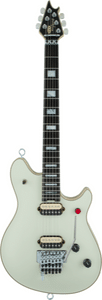
- Maple-topped basswood body
- Two Wolfgang alnico humbuckers (H-H)
- Compound radius fingerboard
- EVH-branded Floyd Rose tremolo system
- D-Tuna
- Red stutter-stop kill switch
- EVH HPU low-friction volume pot
Price (Street): $4,600
Ernie Ball Music Man John Petrucci Majesty
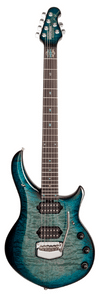
- Mahogany neck-through-body with maple-capped mahogany and okoume body
- 17-inch radius ebony fingerboard
- Recessed neck heel
- DiMarzio Rainmaker and Dreamcatcher humbuckers (H-H)
- Piezo bridge
- Active preamp with gain boost
- JP Music Man custom floating tremolo
- Schaller locking tuners
- Stainless steel frets
Price (Street): $3,800
Ibanez Steve Vai Signature PIA3761

- Alder body
- 5-piece PIA neck with Prestige fret end treatment
- PIA Blossom fingerboard inlay
- DiMarzio UtoPIA pickups (H-S-H)
- Edge tremolo with gold hardware
- Luminlay side dots
- Yin/Yang monkey grip handle
Price (Street): $3,500
Ibanez J Custom RG8570Z

- African mahogany body with AAA flamed maple cap
- 5-piece maple/wenge J Custom Super Wizard neck
- Tree of life fingerboard inlay
- Bound ebony fingerboard with Prestige fret edge treatment
- DiMarzio Air Norton, True Velvet, and Tone Zone pickups (H-S-H)
- Edge-Zero tremolo
- Recessed control knobs
- ZPS3 stabilizes tuning and simplifies string changes
Price (Street): $3,000
EVH Striped Series Frankenstein Relic

- Oil-finished, graphite-reinforced, quartersawn maple neck
- EVH-branded neck plate
- Compound-radius fingerboard
- Basswood body with worn-in relic’d finish
- Direct-mount bridge humbucker
- EVH-branded Floyd Rose tremolo system
- D-Tuna
Price (Street): $2,000
ESP E-II M-1 Thru NT
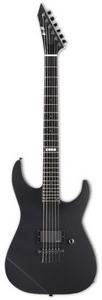
- Maple neck with Thin “U” neck profile
- 24 fret Ebony fingerboard
- Mahogany body
- Single EMG 81 active humbucker
- Gotoh locking tuners
- String-through-body design
Price (Street): $1,900
Ibanez Steve Vai Signature Premium JEM7VP
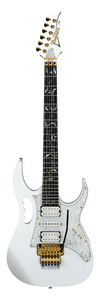
- 5-piece Wizard neck
- 24 Fret ebony fingerboard with Tree of Life inlay
- Alder body
- DiMarzio Evolution pickups (H-S-H)
- Edge tremolo
- Monkey grip handle
Price (Street): $1,800
Schecter Hellraiser C-1 FR-S

- Three-piece mahogany Thin-C set neck
- 14-inch rosewood fingerboard
- Mahogany body with quilted maple top
- Sustainiac humbucker neck pickup
- EMG 81 Humbucker bridge pickup
- Floyd Rose 1000 Series bridge/tailpiece
- Grover tuners
Price (Street): $1,250
Jackson Pro Series Soloist SL2Q MAH

- Oil-finished maple neck-through-body design
- 12- to 16-inch compound-radius ebony fingerboard
- Mahogany body with quilted maple top
- Two Seymour Duncan Distortion humbuckers (H-H)
- Floyd Rose 1000 Series double-locking tremolo
- Jackson sealed die-cast tuners
Price (Street): $1,200
Kramer Baretta Vintage
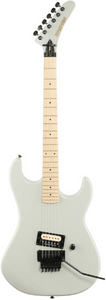
- Maple neck with banana-style headstock
- 14″-radius maple fingerboard
- Maple body
- Slanted zebra-colored Seymour Duncan JB humbucker
- Push/pull coil tap
- Floyd Rose 1000 Series double-locking tremolo
- Mini die-cast machine heads
Price (Street): $700
What Is The Sky Super Strat Guitar?
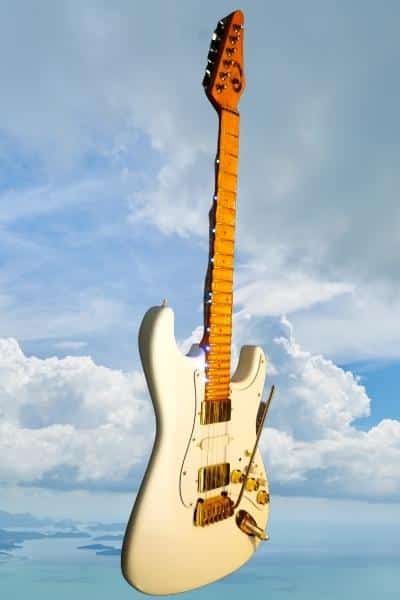
This guitar was not included in the list of Super Strats above because it is in a class all its own in every way!
The Sky Super Strat was designed by Uli Jon Roth as a hat tip to Leo Fender’s timeless Stratocaster design and feel. It takes the Strat to the next level and gives it Sky Guitar superpowers.
It was built to celebrate Uli’s work in the days of the Scorpions and Electric Sun.
The flamed maple neck is deep-scalloped from the third fret. It has 23 super-jumbo frets.
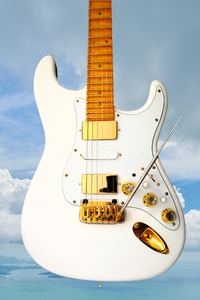
The alder body has 2 gold-plated humbuckers and one single-coil pickup in the middle, with 3 control knobs & 2 push-pull toggle controls.
This guitar’s bridge consists of a gold-plated ABM super smooth floating tremolo with 3 gold-plated springs.
The guitar’s active electronics use an 18-Volt power supply to run the “Mega-Wing” multi-component system that controls the Gain and EQ module. These modules allow the player to adjust the guitar’s volume, treble, midrange, bass, and master gain.
This is what you get when you take a Strat and merge it with a Mega-Wing III system and a Sky Guitar neck. It’s the best of both worlds. If you’re a “Strat Cat,” this guitar is a dream come true!
Price: $16,800 – Available directly from SkyGuitars.com. (If your rich uncle left you some cash, take a serious look at this guitar!)
See Uli Jon Roth Sky Guitar Review – Fabulous To Behold And Play for more info.
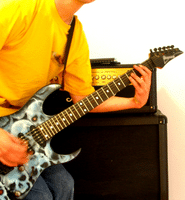
Famous Shredders
Here is a partial list of some of the best shredders out there (in random order). I can’t possibly list them all, but if your favorite player is missing, leave me a comment, and I will update the list. ?
If there are some players you absolutely love, you can make (or buy) a Super Strat similar to the guitar they use. It’s worth researching any of the names you may not recognize since they are all terrific players! Go ahead, have some fun with it.
Eddie Van Halen
Joe Satriani
Steve Vai
John Petrucci
Zakk Wylde
Dave Murray
Jennifer Batten
Kirk Hammett
Yngwie Malmsteen
Tosin Abasi
Marty Friedman
Allan Holdsworth
Nita Strauss
Adrian Smith
Dimebag Darrell
Dave Mustaine
Randy Rhoads
Al Di Meola
Michael Angelo Batio
Paul Gilbert
Guthrie Govan
Janick Gers
Jason Becker
Mattias Eklundh

Frequently Asked Questions
Here are some of the questions I get asked about Super Strats and shredding.
If your question does not appear here, please put it in the comments, and I will get right back to you with an answer.
Who Invented The Super Strat?
There isn’t any particular person who has been credited with the invention of the Super Strat. Players have been modding their Strat-type guitars ever since the invention of the Stratocaster in 1954.
In the 1980s, with the introduction of the Floyd Rose bridge and better pickups, guitar companies began mass-producing Super Strats.
Who Is The Fastest Guitarist?
This is an ongoing question, and players frequently break the guitar speed barrier. The Guinness World Records recognized John Taylor in 2012 as being the fastest player after playing the “Flight of the Bumblebee” by Nikolai Rimsky-Korsakov, error-free, at a speed of 620 beats per minute (bpm).
Since then, many players have claimed to have broken the speed record at over 1,000 bpm!
Can You Shred On A Strat?
You absolutely can shred on a stock Strat! It all comes down to skill level and talent.
Can You Shred On An Acoustic Guitar?
Yes, it is possible to shred on an acoustic, but more limited than on an electric due to limitations like action (string height) and body configuration.
How Do You Make A Stratocaster Play Easier?
There are many ways to make a Strat play easier. The most basic starting point is to use lighter gauge strings and lower action. Some players change the neck to one with a flatter or compound fingerboard radius and jumbo frets.
Who Plays A Jackson Soloist?
Phil Collen was one of the earliest players of the Jackson Soloist, which he played for thirty years! Gary Moore also used a Soloist on his rock-based albums. As the Soloist continued to evolve, it caught the ear of other players.
Mick Thomson and Jeff Loomis have used a Jackson Pro Series Soloist guitar, and each has their own Signature Series model.
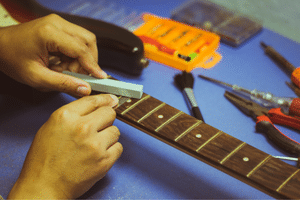
Are You Qualified To Make Guitar Adjustments Or Modifications?
It’s great to work on your guitars, especially if you have a lot of them, but you should always be aware of your limitations.
Adjusting things like an electric guitar’s string height (action) or pickup height can be straightforward. Still, some adjustments require the proper training and experience, like adjusting a guitar’s truss rod.
When you doubt your ability to adjust, repair, or modify your guitar, it’s always best to bring it to a competent guitar technician or luthier (guitar designer & builder). You can permanently damage your guitar, and it might never play and sound right again!
Making modifications to your guitar can void its manufacturer’s warranty and cause permanent damage to the instrument. Certain modifications are irreversible, so you may be stuck with them, even if you desperately want to restore the guitar to its original condition!
I learned that the hard way over the years until I did a three-year apprenticeship in a guitar repair shop. Now I have my own home workshop with the proper training and equipment to safely maintain and repair all my instruments.
Remember: “When In Doubt, Send It Out!”

Final Thoughts
Super Strat guitars are instruments with a Strat-like body shape that have been enhanced to look, sound, and play better. There are many ways to modify a guitar, and it can be hard to say where a Strat ends and a Super Strat begins.
Super Strats are most commonly used for “shredding” since they have flatter necks, higher-output pickups, and double-locking tremolo systems for playing fast passages and keeping the guitar in tune.
Players usually modify their Strats by upgrading the tremolo and pickups to make it a Fender Super Strat.
If you have an expensive or vintage guitar, modifying it can significantly lower its resale value! When you modify a guitar, always keep the original parts, in case you want to restore it to its original condition or sell the instrument.
Sometimes it’s more practical or cost-effective to buy a new Super Strat instead of modifying the guitar you already own.
Never modify your guitar if you don’t know how to do it properly. Making modifications to your guitar can void its manufacturer’s warranty and cause permanent damage to the instrument. Bring it to a certified guitar tech or builder (luthier).

What To Read Next ➡ What Genre Is A Telecaster Good For? (It’s Not Just Country)

Tell Me What You Think
Please leave a comment below if you enjoyed this article, have any questions about Super Strat guitars, or want to give your point of view. I will be happy to help you.
- What type of neck and tremolo do you prefer for shredding?
- Do you own a Super Strat guitar? Which one?
- Which brand and model Super Strat do you like best?
- After reading this article, are you thinking of modifying your Strat?



I had no idea you could do these types of modifications to your guitar. You have written a really thorough guide for anyone looking to make their guitar sound better. There is a wealth of information. I used to play guitar as a teenager but I stopped and for the life of me I don’t know why. Maybe after reading about these cool modifications I’ll pick it up again.
Hi, Jaime
Thank You for your comments!
Yes, quite a lot has changed over the years in the way electric guitars are manufactured and what can be done to improve their sound and playability.
Picking up where you left off with the guitar sounds like a great idea! I wouldn’t be concerned about modifications at this point. Get yourself a starter guitar and begin playing the music you enjoy most.
Frank
Frank,
Let me start by saying I have never owned or played a guitar. So, the notion of modifying a guitar is way outside of my wheelhouse. But if I’m being honest, I have always been amazed at the skill displayed by artists like EVH. I had absolutely no idea of the role played by the various types of guitars.
Your article about the Super Strat Guitar was written in a way that piqued my curiosity. The attention to detail along with the visuals helped me gain a basic understanding of the process required to turn a Strat into a Shred Machine.
However, I think I would much rather purchase my guitar using one of the instruments suggested in your article.
Just curious. Do you play for a living? Modify guitars for a living? Or do a little bit of both?
Stacey
Hi, Stacey
I really appreciate your comments!
I’m thrilled that you liked my article, but please answer me one question. If you love Eddie’s music as I do, then what are you waiting for? Get yourself an EVH Stripe Series Frankenstein Relic (Frankenstrat copy) guitar and get to work! 😊
Seriously, you don’t have to spend that kind of money on a guitar for a beginner. You can get a Fender Squier Bullet Strat for about $200 dollars and it’ll play great. Playing the guitar is more fun than you can possibly imagine.
Yes, I have played, taught, and built/modified guitars for a living.
Please come back again!
Frank 🎸